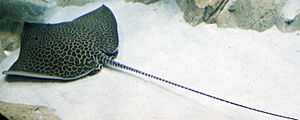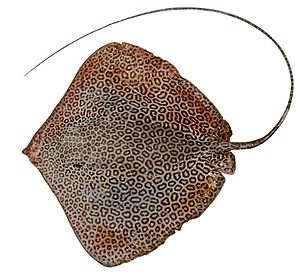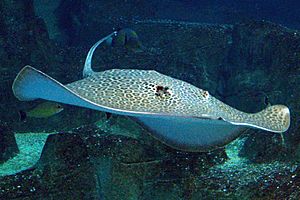Leopard whipray facts for kids
Quick facts for kids Leopard whipray |
|
|---|---|
 |
|
| Conservation status | |
| Scientific classification | |
| Genus: |
Himantura
|
| Species: |
leoparda
|
The leopard whipray (Himantura leoparda) is a type of stingray. It lives in the Indian Ocean and Pacific Ocean, from South Africa all the way to Australia. These rays prefer shallow waters, usually less than 70 meters (230 feet) deep. They like to live on soft sandy or muddy bottoms.
Leopard whiprays can grow quite large, up to 1.8 meters (6 feet) wide! They have a diamond-shaped body and a pointy snout. Their tail is super long and thin, like a whip. Adult rays have a cool pattern of dark brown rings on a yellowish-brown body, just like a leopard. They also have a line of special, heart-shaped bumps along their back. Baby rays look a bit different, with big dark spots. People often catch these rays for their meat.
Contents
How Scientists Identify Them
For a long time, scientists sometimes confused the leopard whipray with other similar stingrays. These include the reticulate whipray and the honeycomb whipray. All three look very much alike in size, shape, and color.
In 2008, two scientists, Peter Last and Mabel Manjaji-Matsumoto, officially described the leopard whipray as its own unique species. They named it leoparda because of its leopard-like spots. The first official specimen they studied was a female ray found near Weipa, Queensland, Australia.
The leopard whipray is part of a bigger group of similar rays. Scientists use genetic tests to study these animals. These tests have shown that there might actually be two slightly different types of leopard whiprays living in the same areas. This means there could be two very similar species that look almost identical!
What Does It Look Like?
The leopard whipray is a large ray. It can grow up to 1.4 meters (4.6 feet) across and 4.1 meters (13.5 feet) long, including its tail. Its body is shaped like a diamond and is wider than it is long. The front edges of its body curve inward, leading to a pointed snout. Young rays have a body that is almost as long as it is wide.
Their eyes are small, and right behind them are two much larger openings called spiracles. These help the ray breathe. Between its nostrils, there's a wide, skirt-shaped flap of skin. The mouth is shaped like a bow, and it has small, blunt teeth. There are about 59 rows of teeth in the upper jaw! They also have five pairs of S-shaped gill slits.
The tail is very thin and whip-like. It can be 2.5 to 3.8 times longer than the ray's body! Most leopard whiprays have one sharp, serrated (saw-like) stinging spine on top of their tail. This spine is about halfway down the tail.
Adult rays have a band of tiny, rough bumps on their skin, from their eyes all the way to their tail. In the middle of their back, they have a line of up to 15 larger, heart-shaped bumps. The two biggest bumps are usually found between their "shoulders."
When they are born, these rays are grayish or brownish with big black spots. They also have dark and light rings on their tail. As they grow, the spots change. When they are about 55 centimeters (22 inches) wide, the spots become hollow, forming the leopard-like ring pattern. The underside of the ray is always white.
Where Do They Live?
The leopard whipray is found in tropical waters across the Indo-Pacific region. This huge area includes places like KwaZulu-Natal, South Africa, eastern India, and Sri Lanka. They are also found throughout Southeast Asia, including the Philippines, southern Japan, and Taiwan. You can also find them near New Guinea and northern Australia, from Coral Bay to the Cape York Peninsula.
These rays live on the bottom of the ocean. They prefer to stay close to the shore in areas with soft sand or mud. They are known to live in waters up to 70 meters (230 feet) deep.
Life and Habits
Scientists are still learning a lot about the leopard whipray's life. This is partly because they were often confused with other similar species. We believe they eat small crustaceans (like crabs or shrimp) and small fish.
Like other stingrays, the leopard whipray gives birth to live young. The baby rays grow inside their mother. They get all the food they need from a special "uterine milk" produced by the mother's body.
Newborn leopard whiprays are about 20 centimeters (8 inches) across and 92 centimeters (36 inches) long. This is smaller than the babies of the reticulate whipray and honeycomb whipray. Young leopard whiprays also don't have many of the special skin bumps that adults have. Male rays become ready to have their own babies when they are about 70 to 80 centimeters (28 to 31 inches) across.
Conservation Status
The International Union for Conservation of Nature (IUCN) has listed the leopard whipray as a Vulnerable species. This means that their numbers are decreasing, and they could become endangered if things don't change.
In many places, especially in Indonesia, people heavily fish for leopard whiprays. They are caught for their meat, and sometimes for their skin and cartilage. Fishermen use different methods to catch them, like large nets that drag along the bottom of the ocean (called bottom trawls) or long lines with many hooks. Many of the rays caught in eastern Indonesia are young ones, which can make it harder for the population to grow.
Images for kids






